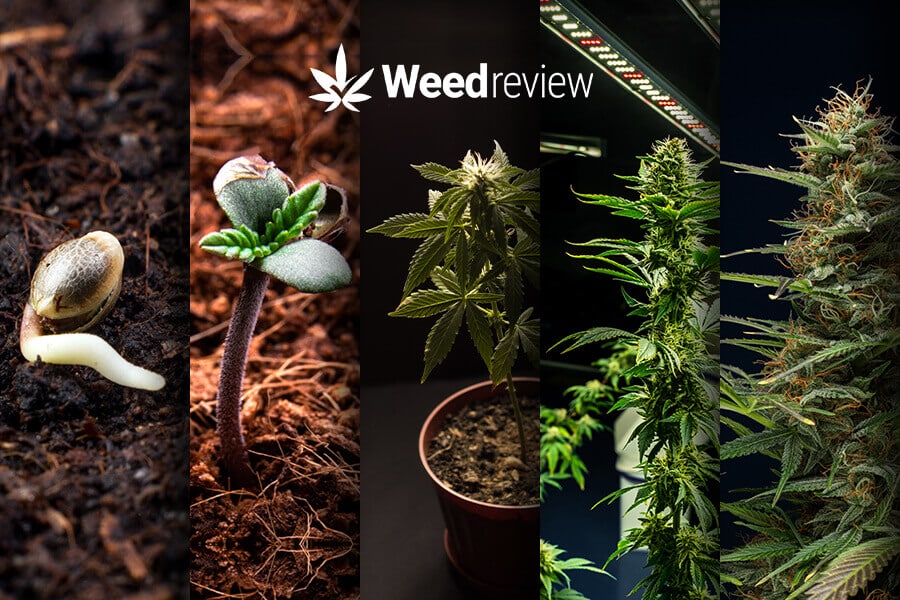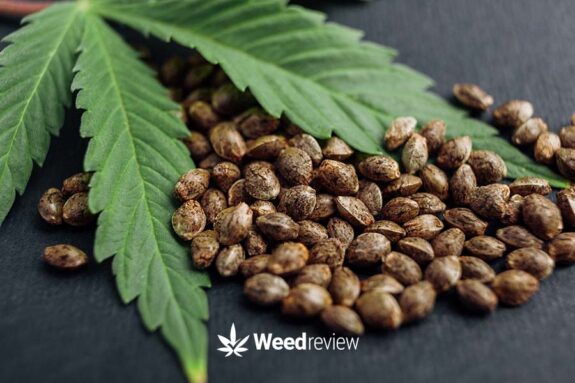
Cannabis Plant Life Cycle: What the Plant Needs at Every Stage

Table of Contents
The cannabis life cycle refers to the stages a cannabis plant goes through, from seed germination to maturity and harvest. It covers the following phases:
- Germination (3-10 days)
- Seedling (2-3 weeks)
- Vegetative (3-16 weeks)
- Flowering (8-11 weeks)
The entire process typically spans 10 to 32 weeks or about 3 to 8 months. Every stage comes with different requirements for the plant; they must be taken care of properly for it to produce the coveted flowers.
We’ll look at each stage of growth in detail. At each point, we’ll cover what you, as a grower, need to know—like how to take care of your seedling or how to train your plants for better growth during the vegetative stage.
Germination
Germination is when a cannabis seed starts to grow. This step is about getting the seed to open up so a small root and a shoot can emerge.
During germination, a cannabis seed absorbs water, which triggers it to wake up from dormancy. The seed’s shell cracks open, and a small root (called a radicle) grows downward while a shoot pushes upwards towards the light.
It also sprouts its first pair of leaves, known as cotyledons. These baby leaves are crucial for absorbing sunlight, enabling the plant to start its growth and development process.
This stage typically takes 24 to 72 hours but sometimes lasts a week.
Here’s how to do it right:
- Keep it moist: The seed needs to be wet to start growing, but too much water is bad. You can use damp paper towels or put it straight into moist soil.
- Warm it up: The best temperature for cannabis seeds to grow is between 20°C and 25°C in a humid environment of 65 – 80%.
- No light needed yet: Seeds don’t need light to germinate. Keep them in the dark until they sprout.
- Be gentle: The new root is very fragile. Handle sprouted seeds carefully.
We recommend you check out our cannabis seed germination guide for a detailed outlook into different methods for sprouting and the best practices to follow.

Seedling
After germination, the cannabis plant enters the seedling stage, where you start seeing the plant’s true personality. It’s a delicate time when the young plant begins to develop its first real fan leaves, beyond the initial cotyledons.
This stage lasts about 2-3 weeks.
As the plant grows, the early leaves evolve, adding more “fingers” – those characteristic pointed segments. Young plants usually have leaves with 1 to 3 fingers, but as they mature, the number of fingers increases, typically to between 5 and 7, though some leaves can have up to 13 fingers in mature plants.
Here’s what you need to know:
- Light is crucial: Seedlings need a lot of light—about 14-18 hours a day—to grow strong. But ensure it’s not too intense to avoid burning the delicate young plants.
- Just enough water: Overwatering is a common mistake at this stage. The roots are small, so they do not need a lot of water.
- No nutrients yet: The seedling can live off the energy stored in the seed for the first couple of weeks. After that, you can start with a very light dose of fertilisers.
Your cannabis plant is vulnerable now – especially to pests and diseases. Careful monitoring and a gentle hand are crucial for setting it up for a healthy vegetative stage.
Many growers prefer to finish the germination and seedling phase indoors before taking the plant outside.
Vegetative
The vegetative stage is critical for building a robust structure to support future buds. During this phase, cannabis plants grow vertically quickly. The root system grows vigorously, the main stem becomes thicker, and branches take shape.
The vegetation phase can last 8-16 weeks or longer, depending on the strain genetics.
In this stage, you will also see the genetics of your plant – Indica, Sativa, or hybrid – on full display. The short nature of Indicas or the tall, lanky stature of Sativas takes shape in the vegetative cycle.
Here is what you should keep in mind:
- Transplanting: The plant is moved to larger pots to support this large growth.
- Temperature & humidity: Keep the growing environment in mind, maintaining humidity levels around 40-60% and temperatures between 22°C to 28°C.
- Height management: Plants can double or triple in size, depending on the strain and environmental conditions. Managing plant height is crucial to ensure they don’t outgrow their space and to maintain optimal light exposure to lower branches.
- Lighting: Cannabis plants thrive on 16-20 hours of light per day during the vegetative stage. The ideal light spectrum leans towards blue, which promotes strong, healthy vegetative growth. Adjust the height of your lights to prevent stretching (too far away) or light burn (too close).
- Nutrients: Plants need plenty of nitrogen, to support rapid leaf and stem growth. A balanced N-P-K (Nitrogen-Phosphorus-Potassium) fertiliser tailored for vegetative growth is essential. Begin with a mild solution and slowly increase the strength as your plants get bigger and show signs of healthy growth. Regularly check for signs of nutrient deficiency or excess and adjust your feeding regimen as needed.
Growers have the option to keep plants indefinitely in the vegetative stage – when cultivating clones from a mother plant. This approach is often used to produce a consistent supply of clones.
Training techniques
Effective training techniques allow growers to influence how their cannabis plants grow, directing energy to areas that will produce the most buds. It is implemented during the vegetation phase to manage its height and growth.
By using different methods, growers can create a more open plant structure that improves light penetration and air circulation, leading to healthier plants and bigger yields.
Here are some key plant training techniques:
- Topping: This technique involves cutting the main stem’s top to encourage horizontal growth and increase the number of bud sites. It’s usually performed when the plant has 4-6 nodes.
- Low-stress training (LST): LST gently bends and ties down branches to expose more of the plant to light without cutting. This method helps the plant grow wider rather than taller, increasing the number of potential bud sites.
- High-stress training (HST): Unlike LST, HST involves intentionally stressing the plant through more aggressive techniques, such as supercropping (gently crushing and bending the stems to create a knuckle) or even breaking branches. This can stimulate the plant to grow more vigorously as it heals.
Flowering
The flowering phase is when the plants stop growing taller and focus their energy on producing buds. It typically lasts 7 to 11 weeks, depending on the strain. Indicas tend to have a short flowering phase, while Sativas flower for a long time, fully using the sun.
In either case, the flowering stage is split into three parts.
Pre-, mid, and late-flowering
- As the vegetative stage transitions into flowering, plants start showing pre-flowers, indicating their sex. Females produce buds, and males develop pollen sacs. This is when you remove males (if growing sensimilla) and prevent pollination of female plants.
The pre-flowering stage lasts 1-3 weeks. - After the initial pre-flowering period, the plant focuses on developing and fattening the buds. This period is crucial for bud growth; you’ll start seeing significant bud size increases. This mid-flowering phase lasts for roughly 2 weeks.
- Then you have the late-flowering or ripening stage, which starts from the 6th week and can last until 10-11 weeks. During this final phase, the buds mature, and you’ll notice increased trichome production and pistil development.
This is also when cannabinoids like THC and CBD are synthesised and accumulate, leading to peak potency.
Mentioned below are the best practices to follow to get healthy flowers:
- Lighting: Switch to a 12/12 light cycle to trigger flowering. This means providing 12 hours of light and 12 hours of complete darkness each day. Switching your lights to emit a red spectrum can better support bud development, as it simulates the fall sun.
- Nutrient: Less nitrogen and more phosphorus and potassium are required to support bud formation. Look for fertilisers labelled for the bloom phase, formulated to meet these changing needs.
- Temperature & humidity: Gradually lower humidity to 40-50% to prevent mould and bud rot. Keep temperatures in a comfortable 18°C to 26°C range. Too much heat can stress plants and reduce their potency and aroma.
- Temperature shock for colours: Cooler temperatures during the late flowering stage can trigger colour changes in certain cannabis strains, enhancing purples, blues, and pinks if genetically predisposed.
- Watering practices: Proper watering is vital to avoid stress. Let the topsoil slightly dry out between waterings to ensure roots get enough oxygen. Overwatering can lead to root problems and affect bud quality.
- Check for pests: With denser foliage and buds, there’s a higher risk of pests and diseases. Regularly inspect your plants and maintain clean, well-ventilated grow spaces to avoid these issues.
- Monitor bud development: Pay close attention to how your buds are forming. This not only helps in estimating harvest time but also allows you to address any issues promptly. Bud size, density, and trichome development are good plant health and maturity indicators.
Harvesting & curing
Harvesting starts with observing your plant’s trichomes, the tiny, shiny crystals on the buds and leaves. Use a magnifier like a jeweller’s loupe to see them.
Trichomes change colour as they mature. They start clear, turn milky white, and then amber.
A good harvest time is when around 70% are milky white and 30% are amber. This mix typically gives a balanced effect. The colour of the trichomes can tell you about the potency and high you can expect. Milky white trichomes tend to give a more energetic high, while amber trichomes can lead to a more relaxing effect.
How to harvest
Handle your plants gently to keep the trichomes intact. When it’s time to harvest, cut your plants carefully, focusing on each branch. Trim away the leaves around the buds while they’re still wet. This is easier and allows for a more precise cut, ensuring you preserve the trichomes and potency of your buds. After trimming, hang the buds upside down in a controlled environment to dry, setting the stage for a successful cure.
How to cure
Curing your cannabis properly is essential because it enhances the flavour, aroma, and overall smoking experience by allowing chlorophyll to break down and ensuring that the cannabinoids and terpenes develop fully.
- Dry slowly: First, you need to dry your buds. Hang them in a dark, well-ventilated room with about 50% humidity, and temperatures around 18-22°C. This process usually takes about a week.
- Improve the flavour: After drying, place your buds in airtight containers, like glass mason jars. Open these jars a few times a day for the first week for about 15 minutes to let fresh air in and excess moisture out. This is called “burping” your buds.
- Be patient: Keep your buds in the jars, continuing to open them less frequently over a few weeks to a few months. The longer you cure, the better the flavour and smoothness of your cannabis.
Can you influence the growth time of cannabis?
Yes, it is possible to reduce or increase the time it takes for marijuana to produce flowers. Various elements come into play, from the basic setup of your grow operation to the specific strain you choose.
Choose indoor farming
Indoor cultivation offers control over environmental conditions, allowing you to initiate flowering earlier. This controlled environment can significantly shorten the growth cycle compared to outdoor cultivation, where plants grow according to the season’s natural light cycle.
Outdoor growers, subject to the whims of weather and seasons, typically see longer vegetative stages but can potentially harvest larger yields due to extended growth periods.
Consider hydroponics
A hydroponic setup can greatly increase yields and speed up the growth time. They allow for precise control over nutrients and pH levels, ensuring optimal plant health and development.
However, hydroponic systems require careful management and are less forgiving than soil grows.
Select the right strain
The genetic background of your cannabis strain has a strong effect on growth duration. Indicas generally reach maturity faster than Sativas, influencing the overall timeline of your growth.
Autoflowering strains, which flower based on age rather than light exposure, provide a quicker route from seed to harvest, making them an appealing choice for those seeking efficiency.
Use growing techniques
Advanced growing techniques and choices, such as using light deprivation outdoors or starting from clones, can also impact the growth timeline. Light deprivation techniques allow outdoor growers to force the flowering stage earlier, reducing the total growth time.
Meanwhile, beginning with clones skips the initial germination and seedling phases, further accelerating the process.
Similarly, you can use training methods like Sea of Green (SOG) to reduce vegetation time and induce flowering much earlier than traditional growth.
Conclusion
Understanding the cannabis life cycle is crucial for successful cultivation. Each stage, from germination to harvest, requires specific care, including appropriate lighting, nutrients, and water management. Strategic choices, such as selecting the right strain and employing effective training techniques, directly influence yield quality and quantity.
That’s why knowing the plant’s growth phases can help you produce exceptional flowers by meeting its requirements at different times.


